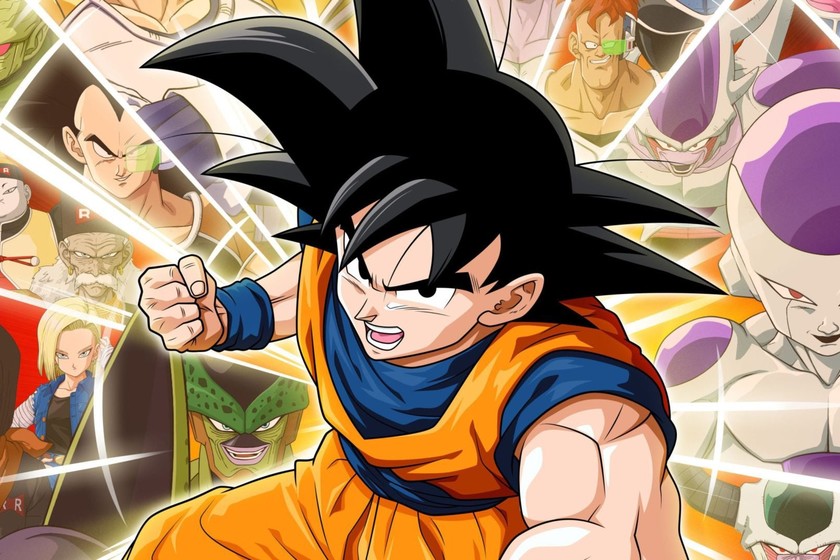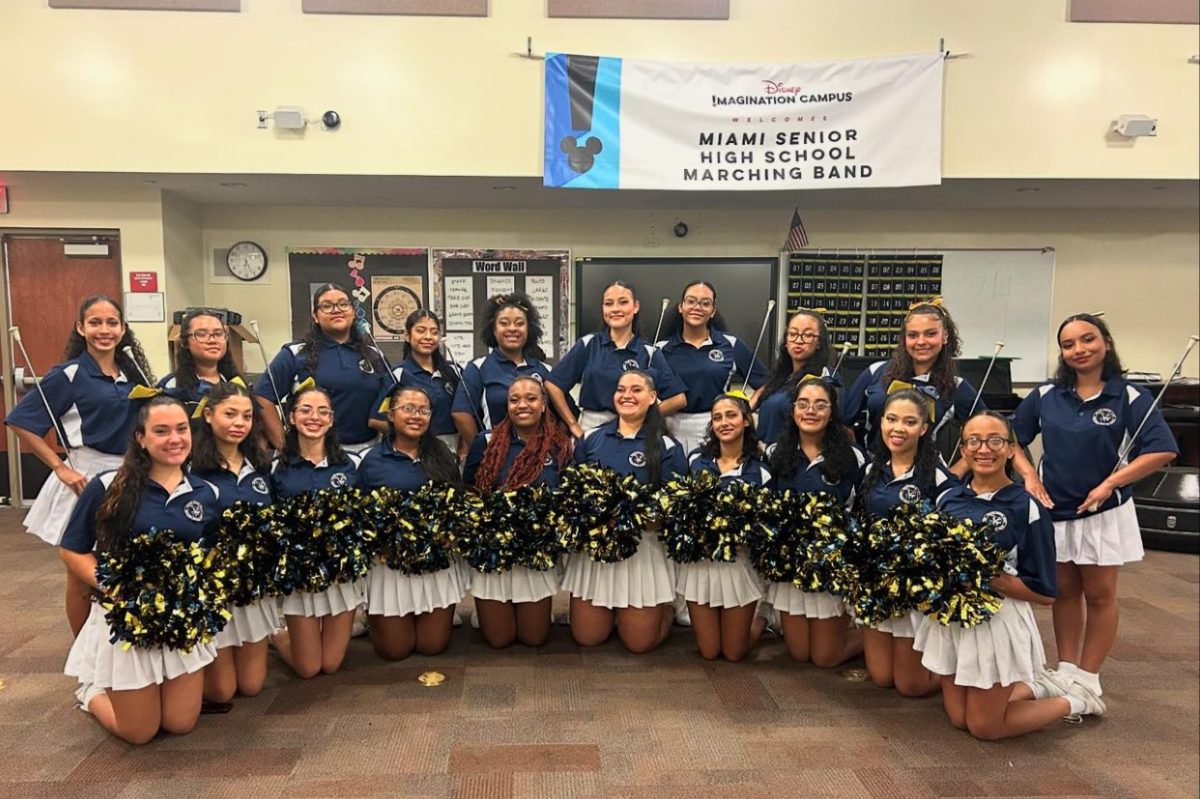Dragon Ball and its Influence On Our Past Generation
The series’ main protagonist, Goku, surrounded by some of the series’ main villains. (Source: vidaextra.com)
May 26, 2023
When it comes to popular animated series popping up year after year, a great portion of them derive from the term “anime”, which is a popular style of Japanese cartoon. Sometimes, you’ll even see students of Miami High walking the halls wearing merchandise of these shows: hoodies, backpacks, and sometimes even shoes!
One of these popular animes, however, seems to have left some sort of chokehold on our generation. That series is Dragon Ball Z, one of the longest running and most well-known anime series.
What Is Dragon Ball Z?
Dragon Ball Z is a 3-decade-long running anime franchise centered around its alien primate protagonist named Goku, true name being Kakarot. Dragon Ball is split up into 8 different series with an additional 17 movies, 4 of which have premiered in theaters.
The story of Dragon Ball’s franchise remains mostly consistent for the majority of its runtime. According to Wikipedia, Dragon Ball itself was inspired by the famous ancient story, Journey to the West, with Sun Wukong basing much inspiration for Dragon Ball’s protagonist, Goku. The story follows the life of this Son Goku, a monkey-tailed boy who embarks on a journey accompanied by a human girl named Bulma and a shapeshifting pig named Oolong to find these magical orbs known as the seven Dragon Balls that can grant any wish once brought together.
Much like a lot of people I’ve met throughout my life, I got into Dragon Ball because of my father. He grew up in Mexico with his brother who loved the series as much as he did in his childhood and thought to project that love for it onto me when he put a rerun of an old episode in Spanish on the TV for me to watch when I was just about 5 years old. Ever since then, I have loved the series with all my heart.
It has influenced me in ways that I never thought it could. It influenced me to pick up a pencil and paper one day in kindergarten and draw the main character to my heart’s content. And ever since that day, it became my biggest comfort series and inspiration to my biggest passion yet: art. I thank the series for helping me discover my love for being an artist and a story writer due to its unique style and story that made me want to draw it out in the first place.
How Has DBZ Influenced the Media?
In the earlier days of anime, there wasn’t much of a format to go off of when creating a story. Dragon Ball helped the foundation of this format with its story arcs and all the important aspects crammed into them.
During the series’ first debut in the late 80’s, it was very difficult to watch anime if you weren’t in Japan. Anime was mostly viewed from VHS tapes that were hard to come across in the first place. And if it wasn’t from VHS tapes, it was through their very late screenings on TV, which was how my father first came across it.
Due to its high demand from audiences across the globe, a company named Toonami came around and got the rights to be able to broadcast these anime’s, Dragon Ball being their main one, outside Japan. Due to this, Dragon Ball Z popularized anime in the West and forever changed its industry, as well as the course of how easily you can view said shows across the world today.
DBZ’s revolutionary influence on anime popularityis due to the following features: transformation sequences, power levels and power scaling, and polar-opposite-to-protagonist rivalry, all stated in CBR.com in the article “10 Undeniable Ways Dragon Ball Changed Anime Forever”.
Dragon Ball’s transformation sequences play a major role in the progression of its story and its characters, especially in its main villains such as Frieza, Cell and Majin Buu, where they all share common transformations which make them more grotesque looking and monstrous for the purpose of getting selfishly stronger. With the main heroes such as Goku, however, their transformation sequences come from within to symbolize their own personal growth.
Its most famous transformation to date is called “Super Saiyan”, a legend within the species that Goku is. This transformation, along with many others that present themselves throughout Dragon Ball, inspired many other famous transformations in popular titles like DBZ. These include Naruto’s Sage Mode from Naruto, Luffy’s Pound Man from One Piece, and Gon’s Muscle Form from Hunter X Hunter.
Another famous transformation sequence that came from this series was the method of fusion, where two characters performed a certain dance in order to merge their forms and become a stronger being. One of Cartoon Network’s mainstream shows, Steven Universe, based their method of fusion directly from Dragon Ball and its fusion dance.
Another big impact this franchise had on many others was their method of power scaling and their power levels. Dragon Ball’s main power system is named “Ki”, a form of trainable and controllable energy that stems from life force, and it can be both physically stored within and physically measured. The concept and foundation of Ki was used in many other popular shounen titles like Hunter X Hunter (Nen), Naruto (Chakra), and My Hero Academia (Quirks), all of which tie down to Ki’s original usage in the series.
A more commonly known fact about DBZ is how important its first and longest rival, Vegeta, was to the series and it’s character development. Vegeta is Goku’s arch nemesis as well as his polar opposite: he is arrogant, egotistical, ruthless, and intelligent. Vegeta comes from the same species and planet that Goku was born on, Planet of the Saiyan’s, and was the prince of the entire species before their race and planet were eradicated.
He is prideful of his Saiyan heritage unlike Son Goku, who is embarrassed by it. With this, Vegeta’s character archetype popularized the concept of a polar opposite rival to a series’ main protagonist. Some of these rivals that Vegeta’s character inspired are: Zuko from Avatar: The Last Airbender, Killua from Hunter X Hunter, Yuno from Black Clover, Sasuke from Naruto, and Bakugou from My Hero Academia, all of which are their show’s antagonists.
How Did Fans Influence DBZ, and How Did The Show Influence Them?
With a fan base and community as large as Dragon Ball’s, there’s no doubt that it hasn’t had at least some sort of impact on the show itself. From its overwhelming popularity and admiration from fans, there’s been at least one instance when this love was reflected back onto its community.
One of these instances was with the series’ highest-grossing movie, Dragon Ball Super: Broly (2018), that made over $124 million worldwide in theaters stated by the Japanese Box Office. The movie’s soundtrack composer, Norihito Sumitomo, inspired the movie’s main battle theme titled “Gogeta VS Broly” off of a trending video that came from Latin America regarding its series finale.
The video consisted of a large group of men chanting the name of the series’ reoccurring main villain, Frieza, on his victory in Dragon Ball Super’s finale premiere. Sumitomo saw this video and thought it was rather heartwarming, to where he inspired the character chant from said video into one of the series’ most hyping battle themes to date.
As for the series influencing its fans, there are many more instances of this happening. Some rather shocking instances are from famous NFL athletes being inspired off of the franchise and its main character for their passion in what they do. Mike Daniels and Chance Warmack are two examples of this, both players openly expressing their love and admiration for the series on social media.
MMA fighters have also fallen into their profession due to their love for Dragon Ball, some even stating that the series was their biggest influence to even join the MMA. Marcos Brimage, a now retired MMA fighter, was commonly seen wearing a scouter, one of the most recognizable devices from Dragon Ball, before his fights.
How Dragon Ball influenced me apart from unlocking my passion for art was how it gave me a taste of how interesting story writing could be. Immersing myself in my own world of stories with my own characters brings me an unimaginable sense of joy when it dials back down to what started it in the first place. It influenced me to take writing classes beyond my level to get as far with my skills as this series has taken it— with world building, character development, or even general analysis.
Famous Appearances and References
Taking into consideration of how popular Dragon Ball really is, it’s made countless appearances in different media, as well as references.
In 2022’s Macy’s Thanksgiving parade, the series’ protagonist Goku appeared with his own float as an honorable throwback to the newest movie of the series releasing in theaters after a 4 year break, Dragon Ball Super: Super Hero.
Cartoon Network shows have also had their fair share of references to either the show itself or to the show’s main character. In an episode of Codename: Kids Next Door, when the character Numbuh 4 tells a story, it’s a parody of early Dragon Ball Z, where the main villains of the show, The Delightful Children Down the Lane, resemble Dragon Ball’s more infamous villain, Frieza.
Teen Titans GO! also makes a reference to Goku in which the main character Robin attempts to fix his messed up hair which results in the haircut Goku has. The show has also made another reference to another Dragon Ball character, Gohan, where the troopers wear helmets identical to that of The Great Saiyaman’s, Gohan’s super hero alter ego.
Nickelodeon series The Fairly OddParents references a show named “Maho Mushi” that is a parody of Dragon Ball Z, featuring characters similar to Goku, Vegeta, and Piccolo.
Comedy Central’s South Park: Bigger, Longer, and Uncut (1999) features a scene where Cartman swears and blasts electricity that looks similar to Ki attacks from the series’ main power system.
Lastly, famous rappers and singers such as Linkin Park’s main vocalist and rapper Mike Shinoda and singer Christina Aguilera have both referenced the series in some of their music. Mike Shinoda has a rap song named “Spell It Out” which samples the main theme song of one of the series’ main villains, Cell, in “Perfect Cell’s Theme”. In Christina Aguilera’s music video “What a Girl Wants”, a picture of Goku and Super Saiyan 4 Goku are seen in the background.
What I Like Best About DBZ
Despite all the reasons why DBZ has become such an inspiring and loved series by many in the past generation, what I like best about it might not resonate with everyone.
I love many aspects of DBZ such as their original concepts, fun worldbuilding and deep main and side stories, but my absolute favorite thing about DBZ is its unique characters. It’s not very common to see so many unique designs and archetypes displayed in the way that Dragon Ball does it. From the main characters to villains and side villains, to characters who show up once and never again, it’s very easy to fall in love with them all, whether they are given a deep story or not. The creativity behind the creator Akira Toriyama’s designs is not something to be ignored, especially with how influential they were and still are to upcoming big title series today.
Where To Watch Dragon Ball:
-
Crunchyroll
-
Funimation
-
Hulu
-
Prime Video







Brolylover • Dec 9, 2024 at 2:05 pm
I love broly!